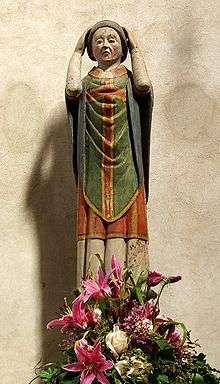Eliphius
Saint Eliphius or Eloff (Élophe, Éliphe, Alophe) is venerated as a Christian martyr. Tradition holds that he was the child of a king of Scotia, and preached in Toul, where he converted 400 people to Christianity.[1] He was accompanied by his siblings: St. Eucharius, and three sisters, Menna, Libaria, and Susanna.[1][2] Tradition also makes him a bishop of Toul.[3]
Saint Eliphius | |
|---|---|
 12th century statue of St. Eliphius in Great St. Martin Church, Cologne. | |
| Bishop and Martyr | |
| Born | Ireland |
| Died | 362 AD Toul, France |
| Venerated in | Roman Catholic Church |
| Feast | October 16 |
| Attributes | Eliphius is sometimes depicted as a cephalophore |
In regard to their alleged royal and Irish birth, James Henthorn Todd states “that we cannot place much reliance on the statement that they were the children of a king of Scotia. Their names are not Irish.”[4] In the 12th century, Abbot Rupert of Duitz (Rupertus Tuitiensis), author of the Acts of the saint, was of the opinion that Eliphius and his siblings were natives of Toul.[4]
In his History of Lorraine, Antoine Augustin Calmet does not mention Scotia (which can refer to Ireland or Scotland) and states that according to some scholars, Eliphius could be a native of Soulosse-sous-Saint-Élophe or Gran;[5] as well as the princely son of a man named Baccius.[2][4]
All of the siblings, except Menna,[2] were beheaded at or near Toul, at the order of Julian the Apostate.[1]
Veneration
They were buried at Mount Eliph.[1] The Lorsch Codex mentions the donation of the relics of St. Eliphius to the Great St. Martin Church, Cologne and was the second named patron of the church.[6] These relics were later transferred to Toul.[6]
| Wikimedia Commons has media related to Saint Eliphius. |
Sources
- "Saints of October 16". St. Patrick Catholic Church:Saint of the Day. Retrieved June 21, 2015.
- Lanigan, John (1822). An ecclesiastical history of Ireland, from the first introduction of Christianity among the Irish to the beginning of the 13. century, Volume 1. An Ecclesiastical History of Ireland, from the First Introduction of Christianity Among the Irish to the Beginning of the 13. Century. Graisberry. p. 8.
- MacManus, Seamus (1921). The Story of the Irish Race: A Popular History of Ireland. Irish publishing Company. p. 237.
- Henthorn Todd, James (1864). St. Patrick: Apostle of Ireland: a Memoir of His Life and Mission, with an Introductory Dissertation on Some Early Usages of the Church in Ireland, and Its Historical Position from the Establishment of the English Colony to the Present Day. Hodges, Smith & Company. p. 195.
- In the 18th century, Augustin Calmet made a scholarly, but unsuccessful, attempt to determine the location of "Gran". He found that the name only appears in the older records. He suggested that "Gran" might be a French contraction of the Latin "Urbs grandis" ("the big town"), and to have referred within the neighbourhood of Toul to that town itself. (Calmet, Augustin (1840) [1756]. "Gran-en-Bassigny". Notice de la Lorraine (in French). 1 (2nd ed.). Lunéville: M. George. pp. 419–425. Retrieved 10 August 2016.). Another possibility is the nearby town of Grand.
- Paul Clemen, Die Kirchlichen Kunstdenkmäler der Stadt Köln II, page 354.